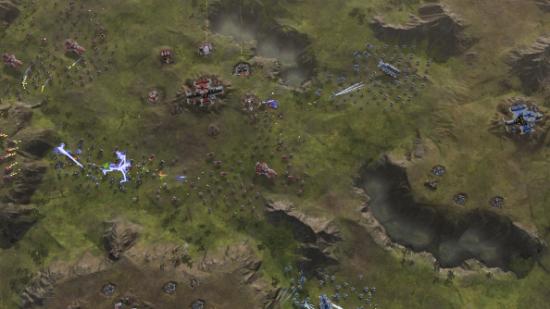Ashes of Singularity is an adherent of the RTS school of thought that places scale above almost everything else. Even on its smallest maps, with only two armies clashing, Ashes’ battles are still gargantuan, dramatic confrontations. Volleys of lasers, plumes of fire and smoke, and countless hovering future-vehicles fill up the screen, and little skirmishes over groups of resource nodes look more like the climactic battle in a major war.
On the surface, it’s a bit like Supreme Commander and, going further back, Total Annihilation, with its massive battles and flashy sci-fi warmachines. This is not really a TA or SupCom successor, however, and while it takes some cues from Chris Taylor’s classic, it takes just as many from the Company of Heroes series and Dawn of War II, with their squads and capture points.
There’s an interesting juxtaposition, then, between the humongous, SupCom-style scraps and the smaller scale of Relic’s games. The result is a game that, so far, manages to be ridiculously big, but not so much that it becomes a chore to manage.
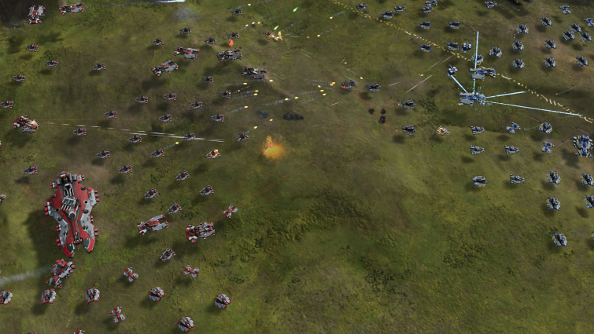
In the only mode currently available, wars are resource races, with teams needing to rapidly build up a base and then venture out into the wilderness to look for metal and radioactive chemicals which can then be spent on more buildings, from all-important base defences to various factories that churn out mechanical units.
Units are spewed out of factories – at a quick pace, I should add – in multiples, and they’re bundled into a group. So the first time you build a unit, you get a squad. There’s no waiting for individual units to pop out of factories. These units can then be ordered to merge with others, transforming the squad into an army, a meta-unit.
Surprisingly, merging them into a gigantic combined force doesn’t create too many headaches. One of Planetary Annihilation’s problems – it also attempted to recreate the scale of TA and SupCom – was that armies were a pain in the neck to manage. They’d spread out, racing to the objective, occasionally getting stuck, and rarely did they feel like a cohesive force. Ashes’ armies move as one, however, gliding across the battlefield with robotic efficiency.
It’s comforting knowing that, when I send an army into an enemy base, they’ll arrive together, able to immediately attack with everything they’ve got. There’s nothing more embarrassing than ordering an attack and realising, too late, that a few units get there ahead of everyone else, essentially letting the enemy know that an attack is coming.
“Hi guys, we’re here for the war. Sorry we’re a bit early.”
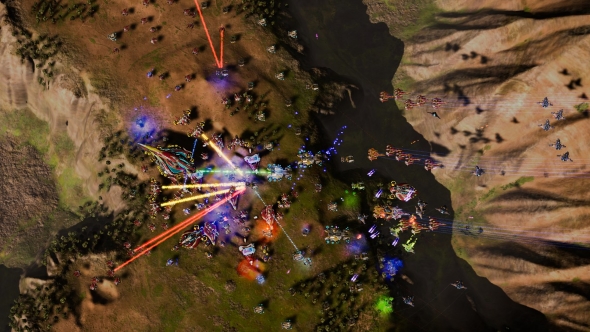
This sensible approach to scale carries over to the maps, which start off big and, at the other end of the spectrum, become almost needlessly huge, yet are broken up into regions that can be fought over. They almost look too large to handle, but Ashes makes you focus on specific regions, which can be conquered, cutting the maps up into easier to manage chunks. Each new zone is an opportunity to rip out more resources from the world, so there’s a clear impetus for expansion, but the game eases you in.
Ashes undoubtedly becomes more interesting once you’ve done quite a bit expanding, though, because that’s when you’ll start fighting with the enemy over choice resources, and that tends to happen quite quickly, though not before you’ve had time to build a formidable force.
My first couple of games didn’t endear me toward Ashes’ AI, but once I cranked up the difficulty (Stardock advises starting on the lowest difficulty because they say that the AI is more challenging than in most RTS games), things started to get a lot more exciting.
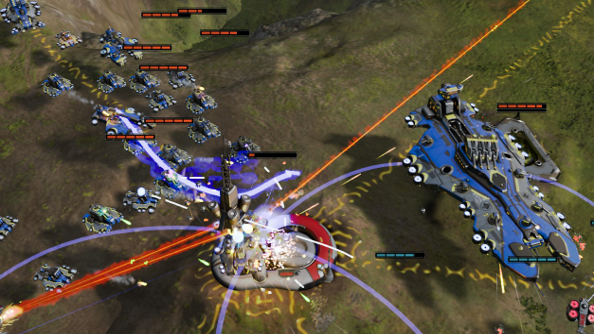
The most memorable game I played also happens to be the first one I lost to the AI. I was doing quite well, I thought. I was extracting resources faster than I could spend them, I had several undefeated armies, and I’d stolen two regions from the enemy by battering them from above with my bombers before swooping in with my ground units to clean up. I was the king of the extremely green world I found myself fighting over.
Pride before the fall, and all that.
I wanted to start building Dreadnoughts, these intimidating, floating warships, and for that I needed more radioactive resources. It just so happened that, in a neighbouring region, there were a few nodes. Luck seemed to be on my side. It was controlled by the enemy, so once again I sent in my largest army, accompanied by aerial bombers.
Mere seconds into the fight it was clear that things were going to be different this time.
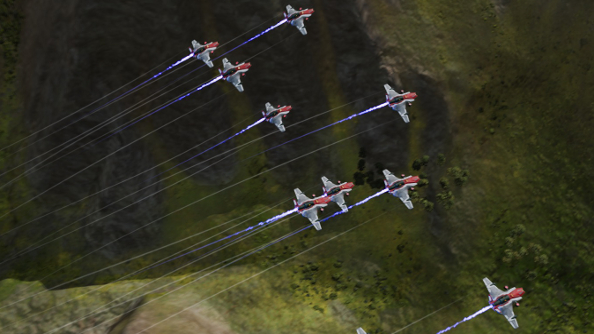
Perhaps the AI had cottoned on to my tactics, or maybe I was just unlucky, but my bombers were immediately shredded by anti-air defences. Without the bombs blowing huge chunks out of the enemy army, the battle slowed down and I had to swallow a lot of unanticipated losses. I was even considering a retreat, and that’s when the second army showed up.
I thought I was facing the bulk of my opponent’s military, but that wasn’t the case at all. This second army, making a beeline for my base from the north, was significantly bigger. I quickly recalled another army that was out exploring and set up the small force in my base in a defensive line. But it was too late. An enemy Dreadnought appeared, coming from the west, backed up by yet another army.
By the time my exploration army made it home, they were all that was left, and all they could do was pepper the invading units with lasers as they demolished my base entirely.
Things can turn bad quickly, and I confess that I had not expected the AI to build up so quickly, nor had I expected them to surround me without me noticing. It was my fault, of course, and though I lost, I still got a tense and properly epic confrontation before everything I’d built was obliterated.
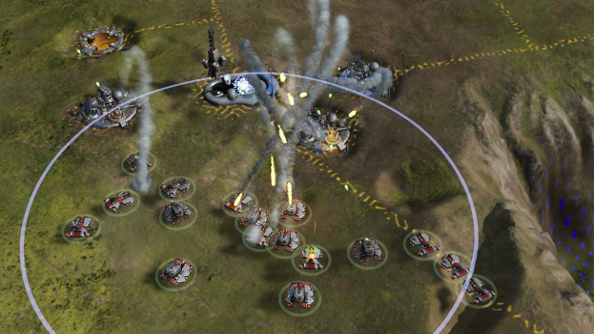
And what a noise! The din of battle is an earful: a deep, reverberating cacophony of pounding bombardments, sucking the air out of the battlefield, accompanied by the shrill threat of constant laser fire. It’s a glorious auditory delight, and between this and Star Wars Battlefront, I think I need to upgrade my speakers.
Fights like that also remind me that Ashes has been built for reasonably meaty PCs. The range of options mean that a relatively modern rig will be able to handle the game, but not necessarily on high or maximum settings. With hundreds of units moving around and explosions and smoke filling up the screen, performance tanked.
With my Intel i5-3570K @3.40 GHz, 8 GB of RAM, GeForce GTX 970 with Windows 10, I was getting an average of 30 frames per second using high settings. It only felt noticeably low during the large battles, though.
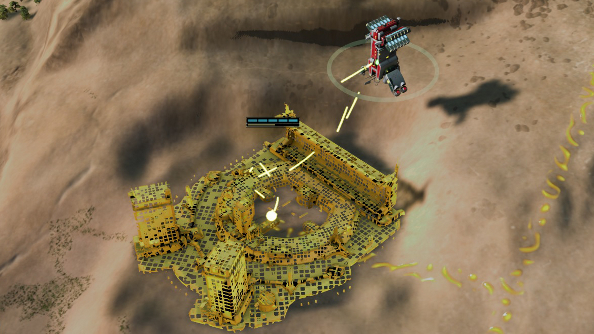
Launching the game in DirectX 12 – alongside Fable Legends, this is the first game with full support – doesn’t make a huge amount of difference. A few gained frames are not particularly obvious, but I suppose it’s better than no performance improvement at all. Two things are worth remembering, however: this is a pre-beta build, and I’m using an Nvidia GPU. The latter is important because Stardock and Oxide Games have partnered with AMD, and it may be that AMD users will see greater performance improvements at the moment.
So you’ll probably have more trouble running it than, say, StarCraft II, but it’s clear why it’s a bit more demanding. There’s the scale, of course, but it’s particularly lovely to stare at as well. The maps, while a bit pedestrian, mostly being green plains punctuated by imposing mountains, are richly detailed, as are the units of the single faction that’s currently available. Up close, there’s impressive diversity, though they all remain thematically connected.
And you can zoom in really close. And very far out. The lack of a strategic zoom, then, is a very odd omission, and I hope one that will be rectified as development continues. While you can see most of the map, you can’t see all of it, and worse, it’s impossible to tell, at a glance, what the units are. Ashes would benefit greatly from some icons.
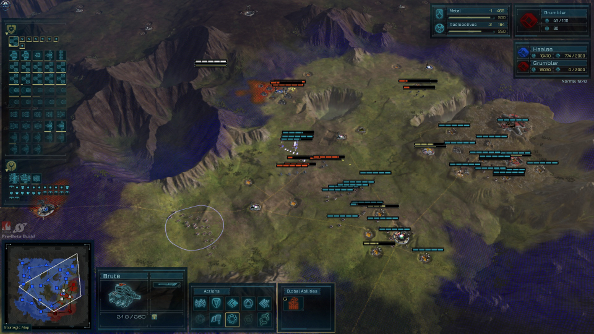
The UI, at least, lets you see every unit you’ve got, and a dozen other things. It’s certainly informative, but at the moment it’s also incredibly cluttered and a little hard to read. I don’t want that information hidden away, but I’d definitely like it to be cleaner and easier to understand when I’ve got so many other things to worry about.
Early Access strategy games are a bit odd, I think. It’s a genre that relies on precision and balance, and both of those things tend to be worked on later. Yet Ashes of the Singularity, even with its single skirmish mode and basic multiplayer features, is already a lot of fun to play. And this isn’t just because it’s gargantuan. That’s a hook, but it’s how the game handles that scale, and how it makes both the micro and macro elements work together, that makes it stand out.
If I do have a concern, it’s the the SupCom comparisons. There are similarities, certainly, but critically, Ashes doesn’t give you a powerful yet vulnerable command unit, and it’s very much doing its own thing, taking what works from several other RTSs, while tweaking and changing them to fit an original game. Anyone coming to Ashes in the hopes of playing a spiritual successor to SupCom may end up disappointed, but it could have a lot to offer players looking for something a little different.
